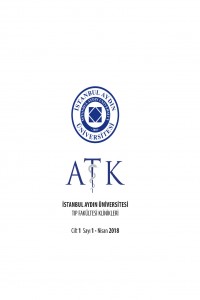Öz
The body temperature is kept at a constant value with heat transfer. Conduction, convection, and radiation, as well as evaporation, play a role in this regulation. The heat is removed from the hot body with evaporation. This is achieved via sweat glands. Three types of glands; eccrine, apocrine, and mixt type are found in the human skin. Sebaceous glands also open to apocrine sweat canals. These glands make the skin surface sebaceous during evaporation. The sebaceous surface protects skin from pathogens. There are odor and coloring on the surface of the skin which has the apocrine, the mixt type sweat glands and the sebaceous glands. Various molecules have responsibility for the coloring. The fundamental cause of odor is bacteria. Various molecules are responsible for odor formation. Eccrine sweat glands only provide sweat release. Peripheral and central systems play a role in regulating sweat release. Hyperhidrosis is a disorder of excessive sweating due to over-stimulation of cholinergic receptors on eccrine glands. Hyperhidrosis is caused by extreme central nervous system induced stimuli to the eccrine sweat glands which found in the hands, feet and armpit skin. Hyperhidrosis is not a life-threatening disease but affects one’s social life negatively. Some drugs, ETS surgery, Botox application and iontophoresis are used for hyperhidrosis treatment. Iontophoresis which should be applied first is a galvanic current therapy, and its side effect is almost none.
Anahtar Kelimeler
Kaynakça
- 1. Guyton AC. Vücut Sıcaklığı, Sıcaklığın Düzenlenmesi ve Ateş. In: Çavuşoğlu H, Yeğen BÇ. Tıbbi Fizyoloji. Onbirinci Basım. İstanbul: Nobel Matbaacılık; 2007. s. 73 (889-900).
- 2. Lacy A, Holowatz W, Kenney L. Peripheral mechanisms of thermoregulatory control of skin blood flow in aged humans. J Appl Physiol 2010; 109(5):1538-44.
- 3. Karabulut AA. Physiology of Sweating. Turkiye Klinikleri J Thor Surg-Special Topics 2016;7(3):1-10.
- 4. Wingo JE, Low DA, Keller DM, Brothers RM, Shibasakiand M. Heat stress in humans Skin blood flow and local temperature independently modify sweat rate during passive J Appl Physiol 2010; 109 (5):1301-6.
- 5. Apilioğulları B, Bilgiç Ö. Hiperhidrozis tedavisi. Genel Tıp Derg 2014;24:79-84.
Öz
Isı enerjisi aktarımı ile vücut sıcaklığı sabit bir değerde tutulur. Vücut sıcaklığının düzenlenmesinde iletim, taşıma ve ışımanın yanı sıra buharlaşma da rol oynar. Buharlaşma ile vücuttan ısı daha sıcak olan ortama atılır. Bunu sağlayan ter bezleridir. İnsanda ekrin, apokrin ve apoekrin ter bezleri vardır. Sebase bezler de apoekrin ter bezlerine açılır. Bunlarla hem buharlaştırılacak sıvı deri yüzeyine atılır hem de deri yağlanır. Böylece deri organizmayı dış etkenlerden korur. Özellikle apokrin, apoekrin ter bezleri ve sebase bezlerin içeriği deride renklenme ve koku oluşturur. Bu renklenmeden çeşitli moleküller sorumludur. Kokunun temel nedeni ise bakterilerdir. Çeşitli moleküller koku oluşmasından sorumludur. Ekrin ter bezleri ise vücuttan yalnızca ter atılımını sağlar. Bunların düzenlenmesinde periferik ve santral sistemler rol oynar. Özellikle el, ayak ve koltuk altında bulunan ekrin ter bezlerinin santral sinir sistemi kaynaklı uyaranlar sonucu aşırı olması hiperhidrozis olarak adlandırılır. Hiperhidrozis hayati değildir ama kişinin sosyal yaşantısını olumsuz etkiler. Tedavisinde ilaçlar, ETS ameliyatı, botoks uygulaması ve iyontoforez kullanılır. İyontoforez gerçekte bir galvanik akım tedavisidir. Önce uygulanması gereken bu tedavinin yan etkisi yok denecek kadar azdır.
Anahtar Kelimeler
Kaynakça
- 1. Guyton AC. Vücut Sıcaklığı, Sıcaklığın Düzenlenmesi ve Ateş. In: Çavuşoğlu H, Yeğen BÇ. Tıbbi Fizyoloji. Onbirinci Basım. İstanbul: Nobel Matbaacılık; 2007. s. 73 (889-900).
- 2. Lacy A, Holowatz W, Kenney L. Peripheral mechanisms of thermoregulatory control of skin blood flow in aged humans. J Appl Physiol 2010; 109(5):1538-44.
- 3. Karabulut AA. Physiology of Sweating. Turkiye Klinikleri J Thor Surg-Special Topics 2016;7(3):1-10.
- 4. Wingo JE, Low DA, Keller DM, Brothers RM, Shibasakiand M. Heat stress in humans Skin blood flow and local temperature independently modify sweat rate during passive J Appl Physiol 2010; 109 (5):1301-6.
- 5. Apilioğulları B, Bilgiç Ö. Hiperhidrozis tedavisi. Genel Tıp Derg 2014;24:79-84.
Ayrıntılar
| Birincil Dil | Türkçe |
|---|---|
| Konular | Klinik Tıp Bilimleri |
| Bölüm | Derleme |
| Yazarlar | |
| Yayımlanma Tarihi | 1 Nisan 2018 |
| Kabul Tarihi | 6 Ağustos 2018 |
| Yayımlandığı Sayı | Yıl 2018 Cilt: 1 Sayı: 1 |
All site content, except where otherwise noted, is licensed under a Creative Common Attribution Licence. (CC-BY-NC 4.0)



